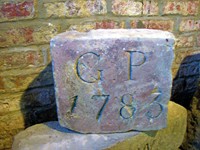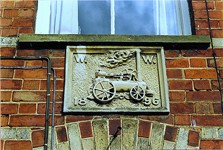 |
 |
Date stones provide a guide to
our old buildings
by REX NEEDLE
|
You need to look up to see them but the result can be rewarding for anyone interested in the history of this town. I refer to date stones, those small plaques on the walls of buildings, usually at the front, with a set of initials and the year of construction that have been included as a reminder for posterity. There are several locations around Bourne where they can be seen and provided the building has not been drastically altered they are a reliable provenance to its origins. One of the oldest we have is no longer in situ but dates from the late 18th century and bears the initials G P which stands for George Pochin who was Lord of the Manor of Bourne Abbots for 37 years until he died in 1798. He lived at the Abbey House, a grand mansion standing next to the church where the vicarage gardens are today, and in 1783 he built a new coach house and stable block further along Church Walk but on the opposite side where this date stone was incorporated. The last of these buildings were finally demolished in 1985 to make way for the present block of flats which now occupies the site when workmen discovered the date stone and were about to throw it away when it was spotted by local councillor, the late Don Fisher, who recognised the initials and rescued it for display at the town’s Heritage Centre in South Street. A second date stone was found with it bearing the inscription WRW 1902, referring to William Robert Wherry (1841-1915) and the opening of his new pea factory in Church Walk on the site of the old stables. That too is preserved in the Heritage Centre. The Wherry family have been associated with Bourne for the past two centuries and are remembered both for their enterprise and commercial success and for their continued service to the community that has been unequalled since. William Wherry senior (1803-82) built a family home at No 17 North Street with shop premises below and the building remains in use today. Wherry's Lane runs alongside where a stone plaque bearing the initials W W and the date 1846 can still be seen in the rear gable end of the building. There are two plaques to remember William David Bell (1798-1857) who in 1820 founded the influential family law firm which played such an important part in the life of the town with offices and a house at No 18 West Street where these stones were built into the rear and side walls with the initials WDB and the dates 1834 and 1847, the years of construction and a later extension. All of the important legal posts in Bourne were held by three generations of the family for over 100 years including clerk to the magistrates, coroner and county court registrar, and William’s descendants remained in Bourne until 1940 when his grandson, Cecil Walker Bell, (1868-1947), retired to live his final years on the south coast. The 19th century brought a large number of date stones to Bourne mainly through the efforts of William Ann Pochin (1820-1901), a descendant of George Pochin, who inherited the title of Lord of the Manor of Bourne Abbots as a boy and held it for over seventy years. During his time in office he built many red brick properties around the town and left his mark, the best example being on the front gable end of Nos 30 and 32 West Street which he erected in 1872 and even left his mark on the drainage pipes. Pochin built many other properties in the locality, large and small houses that survive to this day such as Acacia Villas, a terrace of five dwellings further along West Street, also built in 1872, and the farmhouse and outbuildings at No 50 North Road built in 1896, all of which are so marked. There is also a barn at Twenty bearing his initials and the date 1898 and a house at Toft dated 1873. One of the more decorative examples can be found in Eastgate on the front of the large and stylish corner store built by John Branston in 1860. The premises were extended and modernised by his son Thomas Elmore Branston in 1909 and he was so pleased with his work that he added the clock and his initials on the front façade. The original timepiece was restored by a later tenant and the store has since been turned into a private house although the date stone remains intact. None however can be as picturesque and as interesting as that left by William Walpole (1843-1907), an agricultural contractor, who lived at Dyke where his business was hiring out threshing machines at harvest time. He bought a stone cottage in the main street which he extended and added a red brick frontage including an elaborate date stone for 1896 and a reproduction of a steam traction engine which was the driving force of his trade and this remains intact today. Date stones may indicate that a building has some history but they are still being used for new ones and we have a fine example of this in Crown Walk off West Street, a comparatively recent development based on the former 18th century Crown Inn which closed in 1991. The property then stood empty for three years but developers saw the potential of the site by modernising the old inn building and adding an arcade of retail premises which opened in 1994 with a most attractive date stone to mark the occasion. There are many more around, especially in the older areas of the town such as Eastgate as well as in the rows of terraced and detached houses that can be found in the town centre. The initials are usually readily interpreted although some can only be identified by a search through the deeds of the property. Nevertheless, just walking and looking can be a rewarding pursuit for anyone with an interest in our past. |